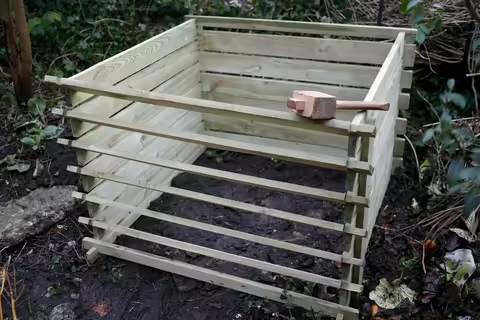URBANA, Ill. – This fall use leaves to grow next year’s healthier garden. By adding fallen leaves to compost, homeowners can save money, improve soil quality, and act more environmentally friendly.
“The science behind composting may sound technical, but it is as simple as throwing leaves and food scraps in a pile and using a shovel to move it around,” says Sarah Vogel, University of Illinois Extension horticulture educator. “Composting can be a great way to reduce the amount of biodegradable material entering landfills and save money by reducing lawn bag use.”
Compost is organic material, meaning it comes from an organism that was once alive. Composting is the breakdown of organic material through controlled decomposition. This decomposition can occur aerobically with oxygen, anaerobically without oxygen, or sometimes, even with worms.
Aerobic composting, or allowing oxygen into the mix, can be accomplished on the ground or in a tumbler. A tumbler is a receptacle that keeps things tidy and is easy to turn but dries out faster and does not receive beneficial microbes from the soil unless added. For those who have a small garden or do not produce a lot of organic waste, a tumbler may be a good option.
“Many people compost in a pile or a bin system,” Vogel says. “There are several do-it-yourself bin systems also available for purchase. A pile is a very simple way to start and easy to access when turning the compost.”
Depending on the size of the compost pile, what is added, and how often it is tended, compost can take anywhere from 90 days to two years to become usable. Using the three-bin or three-pile method, each of the three piles are in varying stages of development: new, partly aged and usable. Composters can speed up the process by turning more frequently.
To start a compost pile, select a shady spot as moisture content will remain important for decomposition. To create good compost, use one-part green materials (the nitrogen component) and two parts brown materials (the carbon component). Add greens and browns in alternating layers, occasionally adding non-glossy newspaper or a bit of soil. Turn every 30 days to aerate and mix.
- Greens: Kitchen scraps and coffee grounds, fresh grass clippings, livestock manure.
- Browns: Fallen Leaves, non-glossy shredded paper or cardboard, wood ash, straw, sawdust, hair trimmings.
- Do not compost: Diseased or pesticide treated plants, weeds with seed heads, twigs, meat or bones, dairy products, human or pet waste.
Compost will produce heat as a by-product of the microbial breakdown of organic material. The amount of heat will depend on the size of the pile, moisture content, aeration, and the carbon-to-nitrogen ratio. When the compost is ready, it will be dark in color and smell earthy and rich.
How a compost smells will tell you a lot about how to troubleshoot any issues.
- For an "off" odor, add browns.
- Damp and smells sweet, but not heating up, add greens.
- Ammonia smell, add browns.
- Compost is dry, add material in layers and cover to lock in moisture.
For more information contact your local Extension office, or visit the Illinois Extension composting website at extension.illinois.edu/global/composting-resources.
SOURCE: Sarah Vogel, Horticulture and Natural Resources Educator, Illinois Extension
ABOUT EXTENSION: Illinois Extension leads public outreach for University of Illinois by translating research into action plans that allow Illinois families, businesses, and community leaders to solve problems, make informed decisions, and adapt to changes and opportunities.
PHOTO ACCESS: The photo in this article is available to download for media use.
